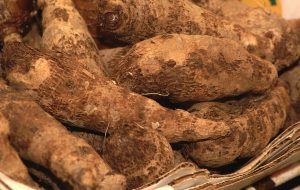Cattle may get a tasty treat soon – feed from sweet potato vines. New research from the University of Florida Institute of Food and Agricultural Sciences are researching the industrial sweet potato variety (CX-1) to produce both feed and biofuels. The vines are traditionally disposed of during harvest, as are the roots. However, research is showing that while the roots can be used to make biofuels, the vines make for a nutritional cattle feed. The research was published in the Journal of the Science of Food and Agriculture.

UF/IFAS researchers have found a sweet potato variety, CX1, that outperformed two table varieties in field tests. They think CX1 potatoes may serve well as feed for livestock and as biofuel.
“The agriculture industry in Florida is looking to find new, viable crops to replace the citrus groves that have been diminished by the greening disease,” said Post-doctoral researcher Wendy Mussoline. “Potato farmers are also trying to find new crops that offer both biofuel alternatives as well as food and/or animal feed opportunities. They are conducting field trials on several varieties of sweet potatoes to determine if they are an economically viable crop that they can market.”
According to a newly published study by professor Ann Wilkie and Mussoline, China produces 81 percent of the world’s sweet potatoes. although U.S. sweet potato production reached a record high of 3.2 billion pounds in 2014, according to the U.S. Department of Agriculture (USDA).
Wilkie and Mussoline found that CX-1 is a superior choice as a dual-purpose crop than the so-called “table” varieties – which people would normally eat — known as Beauregard and Hernandez. They determined this by putting the three varieties through multiple tests in the field and in the laboratory in Gainesville, Florida.
The study demonstrated CX-1’s value as animal feed and promotes the industrial sweet potato crop as a nutritious animal feed. Although the use of sweet potatoes in the U.S. would be new, it’s already being used as a feedstock in China and Brazil.
Wilkie added, “The sweet potato is a high-yielding crop suited to tropical and subtropical climates that requires minimal fertilization and irrigation, and the CX-1 industrial cultivar offers superior potential for feed and fuel.”
